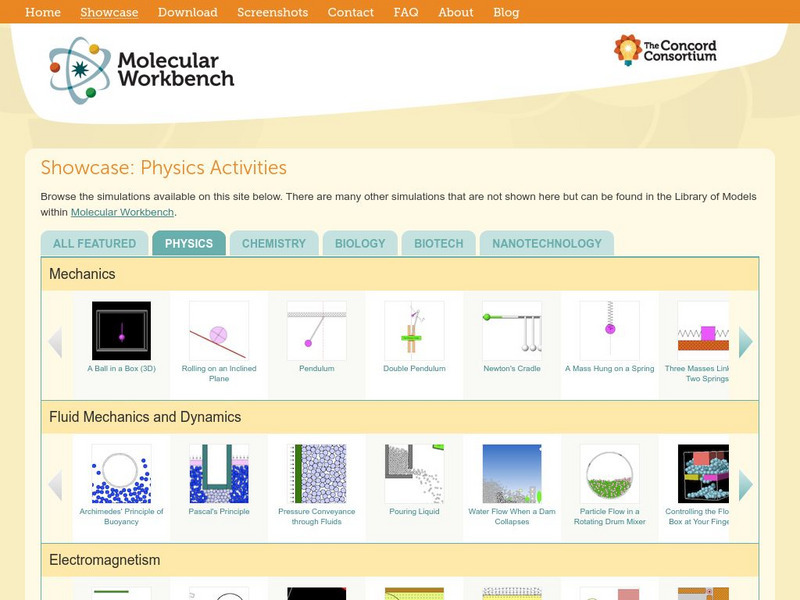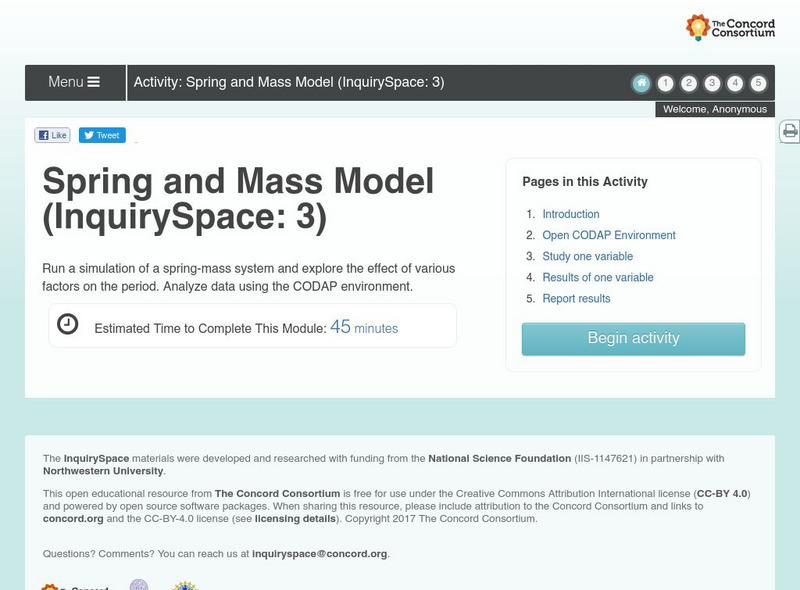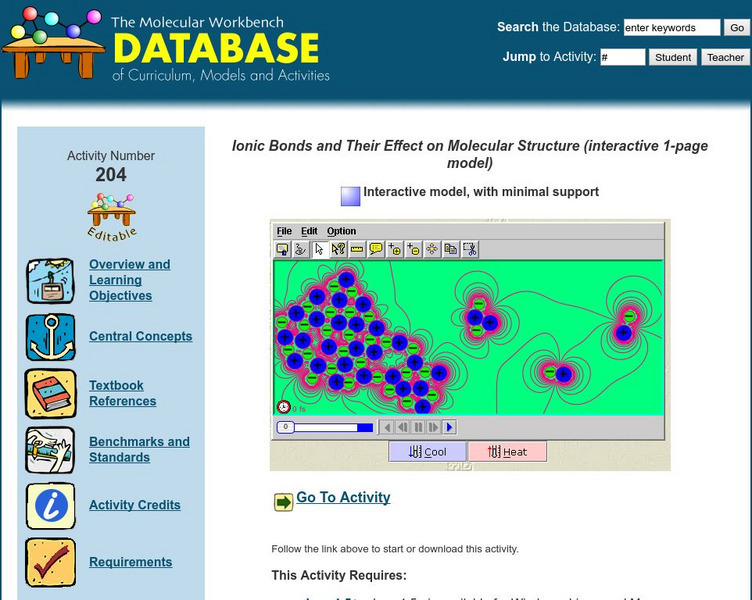Concord Consortium
Concord Consortium: Stem Resources: Pendulum
An interactive tool where students can explore how a pendulum works, and how length, mass, angle, and friction affect its motion or period. As the pendulum moves, its motion is shown in an angle-time graph.
Concord Consortium
Concord Consortium: Stem Resources: Pendulum and Spring
An interactive tool where students can explore how a pendulum behaves when attached to a spring, which means the length of the attachment is always changing. As the pendulum moves, its motion is shown on two graphs.
Concord Consortium
Concord Consortium: Stem Resources: Diffusion, Osmosis, and Active Transport
Have you ever wondered how important gases enter and leave cells? Take an up close tour of a pore in a cell membrane. Then explore diffusion, osmosis, and active transport through this collection of interactive models.
Concord Consortium
Concord Consortium: Stem Resources: Natural Selection
Build a dam in the middle of an ecosystem and observe how the population of plants and animals adapt to their new environment with this science simulation. Learn how the populations adapt to survive in their new habitat. Then remove the...
Concord Consortium
Biologica: Web Lab, Mendel's Peas
At this site see an online visual of meiosis, fertilization, and inheritance and play a game.
Concord Consortium
Concord Consortium: Molecular Workbench Showcase: Fluid Mechanics and Dynamics
Learn more about fluid mechanics and dynamics concepts through these animations.
Concord Consortium
Concord Consortium: Molecular Workbench Showcase: Physics, Electromagnetism
Students can use these simulations to understand concepts in electromagnetism. Simulations are available on the following concepts: Lorentz Force, The Hall Effect, capacitor, conductor, transistor, cyclotron, static electricity....
Concord Consortium
Concord Consortium: Molecular Workbench Showcase: Physics, Quantum Physics
A collection of simulations to show the important topics of quantum physics.
Concord Consortium
Concord Consortium: Molecular Workbench Showcase: Biotech
Simulations of common biotechnology techniques performed in a laboratory setting. Learn how to complete these techniques and what task they are used for in the lab.
Concord Consortium
Concord Consortium: Molecular Workbench Showcase: Nanotechnology
A collection of simulations on nano materials, nano applications, and machinery at the nano level. Students can learn about carbon nanotubes, material strength, a conveyor belt made on the nanoscale, and sputttering.
Concord Consortium
Concord Consortium: Molecular Workbench Showcase: Chemistry, Chemical Bonds
Simulations to show students the nature of chemical bonds. Simulations include an explanation of stereochemistry, atomic orbitals, chemical polarity, formation of an atom, and a summary quiz.
Concord Consortium
Concord Consortium: Science of Atoms and Molecules: Nucleic Acids and Proteins
Through this activity, students work with macromolecules, proteins and nucleic acids. The focus is on the atomic structure of proteins, how linear polymers are made, and the surface charges of the resulting polymers. . Multiple-choice...
Concord Consortium
Concord Consortium: Molecular Workbench
Numerous molecular biology interactive activities along with a program that can automatically keep models and reports to keep track of progress.
Concord Consortium
Concord Consortium: Spring and Mass Model
An interactive tool where students can explore how a spring behaves, and how changing the elasticity, mass, push/pull force, and friction affect its motion or period. As the spring moves, its motion is shown on a distance-time graph.
Concord Consortium
The Molecular Workbench Database: Models of the Atom's Electron Orbitals
Learn about atomic structure and the multiple theories of atomic structure in this simulation.
Concord Consortium
The Molecular Workbench Database: Ionic Bonds
In this simulation observe ionic bonds and how they affect the structure of the molecule.
Concord Consortium
Concord Consortium: Stem Resources: Geniverse
A virtual world where students conduct genetics experiments on a model species called drakes. After the story narrative is introduced, they engage in a quest to heal a sick dragon. As they play, they will learn about the principles of...
Concord Consortium
Concord Consortium: Stem Resources: What Is Meiosis?
In the virtual world of Geniverse, students study and manipulate the process of meiosis in dragons, and try to choose the right alleles in order to produce the target offspring.
Concord Consortium
Concord Consortium: Leaf Photosynthesis
Use a model to explore leaf photosynthesis and the macroscopic outcome of the photosynthetic reaction.
Concord Consortium
Concord Consortium: Chemical Reactions and Stoichiometry
In this activity, students explore reactions in which chemical bonds are formed and broken. Students experiment with changing the temperature and the concentration of the atoms in order to see how these affect reaction rates. They also...
Concord Consortium
Concord Consortium: Electrostatics
Use a series of interactive models and games to explore electrostatics. Learn about the effects positive and negative charges have on one another, and investigate these effects further through games.
Concord Consortium
The Molecular Workbench Database: Chemical Reactions and Stoichiometry
This simulation helps students investigate the basics of chemical equations. Students will review stoichiometry and what effects their reaction rates.
Concord Consortium
The Molecular Workbench Database: Energy Conservation in Chemical Reactions
Follow the energy conversion from potential to kinetic in this interactive activity that explores total energy in chemical reactions.
Concord Consortium
The Molecular Workbench Database: Chemical Reactions
Observe that chemical reactions follow the pathway the uses the least amount of energy in this simulation.






















